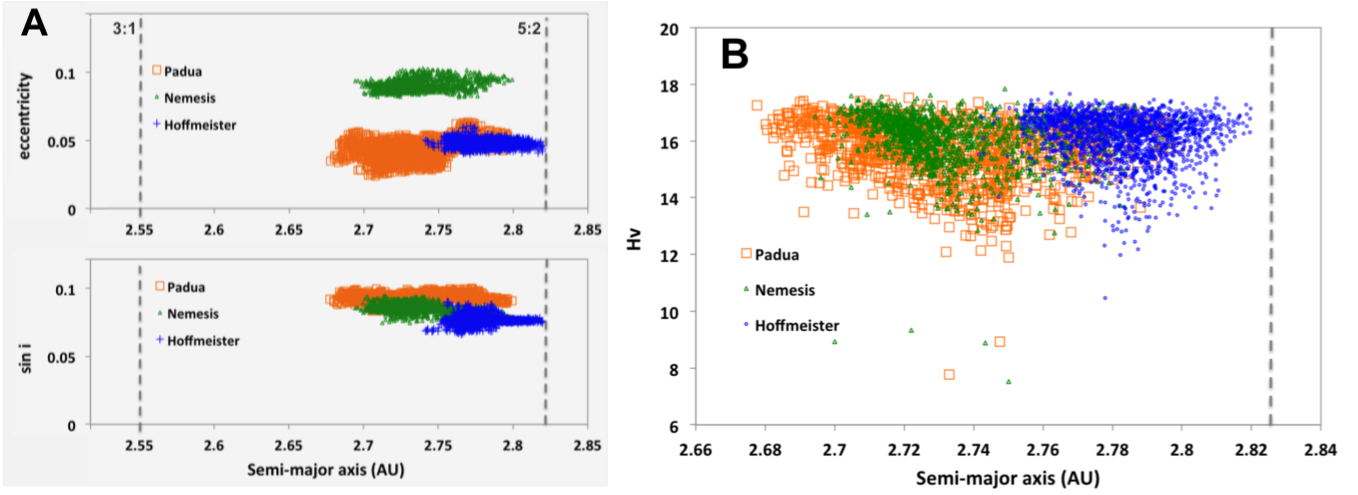- 1Instituto de Astrofísica de Canarias (IAC), C/Vía Láctea s/n, 38205 La Laguna, Tenerife, Spain (damog@iac.es)
- 2Departamento de Astrofísica, Universidad de La Laguna, 38205 La Laguna, Tenerife, Spain
- 3Florida Space Institute, University of Central Florida, Orlando, FL 32816, USA
- 4Physics Department, University of Central Florida, P.O. Box 162385, Orlando, FL 32816, USA
- 5GTC Project Office, 38205 La Laguna, Tenerife, Spain
Asteroids are the remnant blocks of the early stages of the formation of our Solar System. In particular, those classified as “primitive” are believed to contain the most pristine and almost unprocessed materials (water-bearing minerals, carbon compounds, and organics), and therefore they provide unique information on the formation and evolution of our planetary system, including how water appeared on Earth. Among these objects, primitive near-Earth asteroids (NEAs) are of particular interest. Due to their proximity they are impact hazards to Earth, but they are also the ideal targets for space missions. That is the case of primitive NEAs (101955) Bennu and (162173) Ryugu, primary targets of NASA’s OSIRIS-REx and JAXA’s Hayabusa 2 sample return missions, respectively, currently on their way to encounter the two asteroids. The main asteroid belt, located between the orbits of Mars and Jupiter (2.1-5.2 AU), and in particular collisional families, are currently considered the principal source of NEAs (Bottke et al. 2002; Bottke et al. 2005). In the case of the two primitive NEAs mentioned above, several studies have shown that the most likely source is the Polana collisional family (Campins et al. 2010, 2013), a primitive family located in the inner belt. Other large primitive families in that region are Erigone, Sulamitis, and Clarissa. Smaller primitives families like Klio, Chaldaea, Svea and Chimaera can also be found in the same region (Nesvorny et al. 2015).
With the main objective of supporting the science return of OSIRIS-Rex and Hayabusa 2, in 2010 our group started a coordinated effort to characterize the surface composition of primitive asteroids not only in the collisional families of the inner belt, but in the central and outer belt: our PRIMitive Asteroids Spectroscopic Survey (PRIMASS) includes both visible and near-infrared spectra. Up to now, in the frame of PRIMASS, our group has studied several primitive families wihtin the inner main belt: the Polana-Eulalia complex (de León et al. 2016; Pinilla-Alonso et al. 2016), Erigone (Morate et al. 2016), Sulamitis and Clarissa (Morate et al. 2018a), and Klio, Chaldaea, Chimaera, and Svea (Morate et al. 2019). One interesting result was that Erigone. Sulamitis, Klio, Chaldaea, and Chimaera, presented different percentages of asteroids with an absorption band centered at 0.7μm and associated to hydrated silicates, while the Polana, Clarissa, and Svea families showed no signs of hydration. This result remarks the need for spectral characterization as even the families classified all a priori as primitive can show compositional differences.
Continuing with our PRIMASS survey, we started the characterization of the families in the central part of the belt (2.50-2.82 AU). According to Nesvorný et al. (2015), there are at least 5 primitive families in that region, and for the present work we have focused on three of them: Padua, Nemesis, and Hoffmeister. As it can be seen in Fig. 1A, they overlap in the (a, i) orbital parameter space, and two of them overlap even in the (a, e) space. This might be indicative of a common origin and interestingly, the three families show a similar age. They also overlap in the (a, H) space (Fig. 1B), which make them an ideal case to see if we can discriminate between members from each family using spectroscopy. According to the taxonomical classification of their largest member using visible spectra, Hoffmeister is classified as a CF type family (neutral to blue spectral slope), Nemesis is a C-type family (neutral slope), and Padua is an X-type (redder slope). The distribution of WISE albedos (Mainzer et al. 2011) of Hoffmeister is rather different from what is seen on Nemesis and Padua (Fig. 1C), also indicative of different composition. Only spectra will help to compositionally characterize these families and to search for the presence of the 0.7 μm absorption band associated to hydration. This will allow us to compare the level of hydration in families from the inner to the outer belt (De Prá et al. 2017) and map the water inventory of the asteroid belt to constrain evolutionary models.

Figure 1: A) Distribution of the members of the three primitive collisional families in semimajor axis (a) vs. Eccentricity (top panel) and sine of inclination (bottom panel). The three families clearly overlap in the (a,i) space. B) Distribution of the three families in the absolute magnitude (H) - a space. There are clear overlapping regions where we can test if members of each family can be identified using spectra. C) Distribution of the albedos measured by WISE for the members of the three families.
In order to study these three families, we obtained visible spectra for a total of 124 asteroids (44 within the Nemesis and Hoffmeister families, and 36 within the Padua family) using the OSIRIS spectrograph at the 10.4m GTC, located at the Observatorio Del Roque de Los Muchachos (La Palma, Spain). In this work, we will present the first spectroscopic study of the Nemesis, Hoffmeister, and Padua families, and we will compare the results with those obtained for the families located in the inner main belt.
How to cite: Morate, D., de León, J., Licandro, J., de Prá, M., Pinilla-Alonso, N., Campins, H., and Cabrera-Lavers, A.: PRIMASS visits the primitive collisional families in the central asteroid belt:Nemesis, Hoffmeister, and Padua, Europlanet Science Congress 2021, online, 13–24 Sep 2021, EPSC2021-424, https://doi.org/10.5194/epsc2021-424, 2021.

